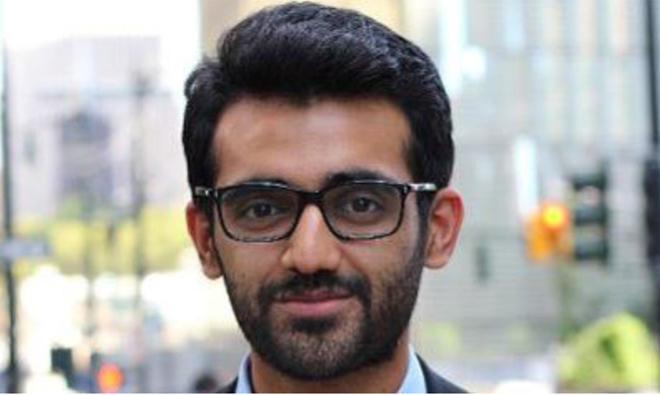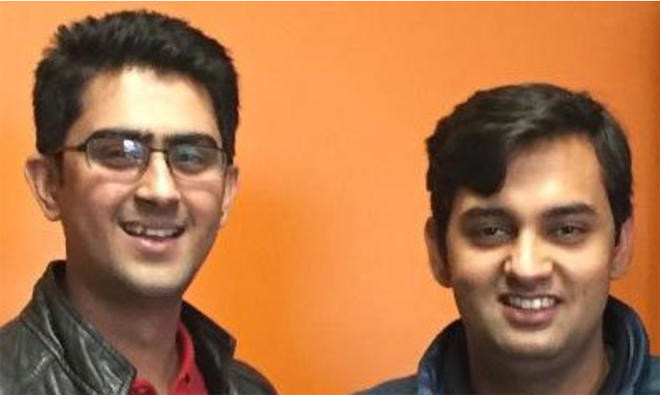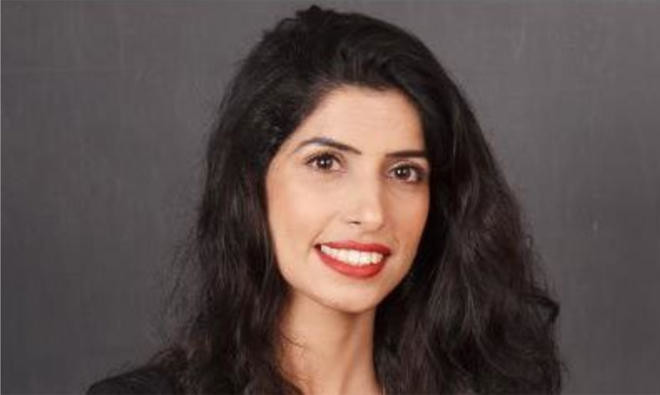ISLAMABAD: Late last year when six Pakistanis made Forbes magazine’s 30 Under 30 in the US, Pakistan was pretty ecstatic. Last night, however, news erupted that for the Asian rendition of the listicle whose spots are the most coveted for young rising stars ... we scored nine spots!
Pakistan has the sixth-largest population in the world, and within that population 60 percent fall in the 18-40 demographic. In other words, we have a large number of young people who can potentially change the world.
Forbes’ list includes a singer who uses her platform for activism, tech and business-savvy individuals, social entrepreneurs and people looking to revolutionize health care in the South Asian country.
Perhaps the most recognizable name on the list is one of Pakistan’s leading singers, Momina Mustehsen. The 25-year-old was catapulted into the spotlight after she performed a record-breaking (we are talking hundreds of millions of views on YouTube, the highest of any from Pakistan) duet to “Afreen Afreen” with Rahat Fateh Ali Khan on the musical production platform Coke Studio. Mustehsen took her platform in stride, using it for a number of awareness campaigns, including one with UN Women.
Sadia Bashir had a mission to help women break into the world of tech and design by way of video game production — and she did just that. She co-founded Pixel Art Games Academy, which provides training in game design, production, gaming programming, digital art and animation targeted at young women. The program is directly responding to the gender gap in the gaming industry. Thirty-three percent of their students are (and always must be) women, a roster Pixel Art Games Academy keeps up through the scholarships Bashir created to encourage women to join.
Brothers in real life and in business, Adnan and Adeel Shaffi, 28 and 29 respectively, are the masterminds behind PriceOye, a price comparison website which they launched in 2015.
Many online shopping websites do not cater to cities outside Islamabad, Lahore and Karachi — a mistake that not only costs retailers but costs the people living outside the big cities as well.
PriceOye does price comparisons for electronics and uses data analytics to help retailers in their own marketing. With website numbers in the hundreds of thousands per month, PriceOye addresses the gaps that traditional e-commerce in Pakistan is not, a gap which leads smaller cities out of the running for great deals.
The singer-activist has been highlighted for her work on women’s issues, cyberbullying, human rights and also for being honored as one of the BBC’s 100 Most Influential Women of 2017.
Neurostic is a health care startup launched by 24-year-olds Muhammad Asad Raza and Abrahim Saha. Neurotstic aims to provide high-quality prosthetics and medical devices (such as cochlear implants) — without the astronomical associated costs. It also addresses clinical decision support, fitness and health monitoring, with a focus on data analytics for health care needs.
Raza and Saha are answering the call of a dire need in Pakistan where health care and resources can be sought to come by. Their prosthetic and implantable devices not only cater to the population in Pakistan but Afghanistan, Iran and Syria as well.
Another Pakistani named for his work in health care is also the youngest of the honorees. Muhammad Shaheer Niazi, 17, is the first to photograph the movement of ions. Forbes named him for the impressive science feat that depicted charged ions creating a honeycomb. This level of research is indispensable to biomedical research. Niazi has also been published in the Royal Society Open Science journal.
At 23, Syed Faizan Hussan is the founder of startup Parihelion Systems. With a mission to use tech-backed products for the improvement of the highest volume of lives, Perihelion Systems is addressing a number of Pakistan’s health issues. Products it has produced include One Health, a tracking and surveillance system used to predict outbreaks of disease, an invaluable resource for a country with a massive population and limited health care resources. Another product is the Edu-Aid, a sign language translating software.
The ninth name to make the list is Hamza Farrukh, 24, a portfolio solutions strategist at Goldman Sachs in London, who in his spare time has embarked on a fantastic social venture helping out in Pakistan. Farrukh is the founder of Bondh E Shams, a solar water project aiming to respond to areas in Pakistan with limited, scarce or no water access. Bondh E Shams, which translates as “droplets of the sun,” comes at a time when certain regions of Pakistan are affected not only by drought but also water that is not safe to drink.
Farrukh’s project has set up two solar-powered wells which provide safe, clean water to 1,500 residents of a small village in Pakistan. One of these wells has the capacity to supply clean water to an estimated 5,000 people every day.
Nine Pakistanis Make Forbes 30 Under 30 Asia
Nine Pakistanis Make Forbes 30 Under 30 Asia

Spanish, Belgian broadcasters say Eurovision televoting ‘encourages manipulation’ after Israel’s result at contest

- Israeli contestant Yuval Raphael unexpectedly came in second place
- ‘A system in which everyone can cast up to 20 votes is a system that encourages manipulation,’ says Flemish parliamentarian
LONDON: Spanish and Belgian broadcasters have accused Eurovision Song Contest organizers of “encouraging manipulation” after the Israeli contestant won their public vote and came second in the 2025 competition.
RTVE, Spain’s public broadcaster, and the Flemish VRT have filed complaints with the European Broadcasting Union, the organizer, requesting an investigation into last week’s televoting system results.
Israeli contestant Yuval Raphael unexpectedly came in second place after Austria’s JJ, who won Eurovision with 436 points with his song “Wasted Love.”
Raphael, who was at the Nova Music Festival in southern Israel when Hamas attacked on Oct. 7, 2023, earned 357 combined points from the jury and public at the Eurovision final on May 17. Her result included 12 points, each awarded by the televoters in Spain and Belgium, despite the countries’ juries giving Israel a score of zero.
The Eurovision televoting system allows viewers to vote up to 20 times for a small fee charged for each vote via text or phone call. Each country’s contestant can earn a maximum of 12 points from either a jury or the public vote. To ensure fairness, contestants do not receive points from their own countries.
Katia Segers, a Flemish parliamentarian, said: “A system in which everyone can cast up to 20 votes is a system that encourages manipulation.
“Whether this manipulation occurred in our country and all other participating and non-participating countries must be investigated.”
She added: “The VRT must take the lead in requesting this investigation, and in holding the debate on the televoting system within the EBU, and on Israel’s participation.”
It was Israel’s second year participating in Eurovision while its military forces continue ongoing attacks in the Gaza Strip, which have killed over 52,000 Palestinians since October 2023.
More than 70 former Eurovision participants earlier this month accused Israel’s public broadcaster KAN of being “complicit in Israel’s genocide against the Palestinians in Gaza” and demanded the exclusion of Tel Aviv from the European contest.
Last week’s final performance by Raphael in Basel, Switzerland, was disrupted by pro-Palestine protesters who attempted to storm the stage. The winner, Austria, will host the 2026 edition.
RTVE’s coverage of the event displayed for 16 seconds a black screen with white lettering in Spanish and English that read: “When human rights are at stake, silence is not an option. Peace and Justice for Palestine.”
The message was perceived as a stance against Israel’s participation. Spanish Prime Minister Pedro Sanchez on Monday called for Israel to be treated the same way as Russia following its invasion of Ukraine in 2022 and to be banned from future contests.
Managing Director of Eurovision Martin Green confirmed that the organization was taking Spain and Belgium’s complaint “seriously.”
He said: “It is important to emphasize that the voting operation for the Eurovision Song Contest is the most advanced in the world and each country’s result is checked and verified by a huge team of people to exclude any suspicious or irregular voting patterns.
“An independent compliance monitor reviews both jury and public vote data to ensure we have a valid result. We remain in constant contact with all participating broadcasters of the Eurovision Song Contest and take their concerns seriously.”
The Smashing Pumpkins to make UAE debut this October

DUBAI: Alternative rock icons The Smashing Pumpkins are set to perform in the UAE for the first time, with a one-night-only concert at Abu Dhabi’s Etihad Arena on Thursday Oct. 9, 2025. The show is part of the band’s global “Rock Invasion 2025” tour and marks their Middle East debut.
Led by founding member Billy Corgan, with longtime bandmates James Iha and Jimmy Chamberlin, the Chicago-born group will deliver a setlist spanning their three-decade career. Fans can expect to hear beloved classics such as “1979,” “Tonight, Tonight,” and “Bullet With Butterfly Wings,” alongside newer tracks like “Beguiled” and “Empires.”
The Abu Dhabi stop is the final leg of their regional tour, which also includes performances in Tokyo, Seoul, Manila, Bangkok, Singapore, and Bahrain. The tour follows the release of their ambitious rock opera “ATUM” and their latest album “Aghori Mhori Mei,” released in late 2024.
Tickets for the Etihad Arena show go on sale through Live Nation Middle East, with artist and presale tickets available starting May 21, and general public sales opening on May 23 at 12 pm.
Gazan twins in Cannes warn ‘nothing left’ of homeland

CANNES: Twin Gazan filmmakers Arab and Tarzan Nasser said they never thought the title of their new film “Once Upon A Time In Gaza” would have such heartbreaking resonance.
“Right now there is nothing left of Gaza,” said Tarzan when it premiered on Monday at the Cannes film festival.
Since militants from Palestinian group Hamas attacked Israel on October 7, 2023, more than 18 months of Israeli bombardment has ravaged large swathes of the Palestinian territory and killed tens of thousands of people.
Israel has vowed to “take control of all” the besieged territory of more than two million inhabitants, where United Nations agencies have warned of famine following Israel’s two-month total blockade.
Israel allowed in several aid trucks on Monday but the UN said it was only “a drop in the ocean” of needs.
The Nasser brothers, who left Gaza in 2012, said their new film set in 2007, when Hamas Islamists seized control of the strip, explains the lead-up to today’s catastrophic war.
“Once Upon A Time In Gaza,” which screened in the festival’s Un Certain Regard section, follows friends Yahia and Osama as they try to make a little extra cash by selling drugs stuffed into falafel sandwiches.
Using a manual meat grinder that does not rely on rare electricity, student Yahia blends up fava beans and fresh herbs to make the patty-shaped fritters in the back of Osama’s small run-down eatery, while dreaming of being able to leave the Israeli-blockaded coastal strip.
Charismatic hustler Osama meanwhile visits pharmacy after pharmacy to amass as many pills as he can with stolen prescriptions, pursued by a corrupt cop.
Israel first imposed a blockade on Gaza in June 2006 after militants there took one of its soldiers, and reinforced it in September 2007 several months after Hamas took power.
“The blockade was gradually tightened, tightened until reaching the genocide we see today,” said Tarzan.
“Until today they are counting the calories that enter,” he added.
An Israeli NGO said in 2012 that documents showed Israeli authorities had calculated that 2,279 calories per person per day was deemed sufficient to prevent malnutrition in Gaza.
The defense ministry however claimed it had “never counted calories” when allowing aid in.
Despite all this, Gazans have always shown a love of life and been incredibly resilient, the directors said.
“My father is until now in northern Gaza,” Tarzan said, explaining the family’s two homes had been destroyed.
But before then, “every time a missile hit, damaging a wall or window, he’d fix it up the next day,” he said.
In films, “the last thing I want to do is talk about Israel and what it’s doing,” he added.
“Human beings are more important — who they are, how they’re living and adapting to this really tough reality.”
In their previous films, the Nasser twins followed an elderly fisherman enamoured with his neighbor in the market in “Gaza Mon Amour” and filmed women trapped at the hairdresser’s in their 2015’s “Degrade.”
Like “Once Upon A Time in Gaza,” they were all shot in Jordan.
As the siege takes its toll in “Once Upon A Time In Gaza,” a desolate Yahia is recruited to star in a Hamas propaganda film.
In Gaza, “we don’t have special effects but we do have live bullets,” the producer says in one scene.
Arab said, long before Gazan tap water became salty and US President Donald Trump sparked controversy by saying he wanted to turn their land into the “Riviera of the Middle East,” the coastal strip was a happy place.
“I remember when I was little, Gaza actually was a riviera. It was the most beautiful place. I can still taste the fresh water on my tongue,” he said.
“Now Trump comes up with this great invention that he wants to turn it into a riviera after Israel completely destroyed it?“
Hamas’s October 2023 attack resulted in the deaths of 1,218 people on the Israeli side, mostly civilians, according to an AFP tally based on official figures.
Militants also took 251 hostages, 57 of whom remain in Gaza including 34 the military says are dead.
Israel’s retaliatory offensive has killed 53,486 people in Gaza, mostly civilians, according to Gaza health authorities, whose figures the United Nations deems reliable.
Gaza health authorities said at least 44 people were killed there in the early hours of Tuesday.
Met returns looted Mesopotamian artifacts to Iraq after investigation

DUBAI: Three ancient Mesopotamian artifacts once housed at the Metropolitan Museum of Art in New York have been returned to Iraq after an investigation into art trafficking linked to the late British antiquities dealer Robin Symes, authorities announced on Monday.
The return was confirmed in statements by the Met and the Manhattan district attorney’s office, which led the criminal investigation. The artifacts — a Sumerian gypsum vessel from about 2600-2500 BC and two Babylonian ceramic heads dated about 2000-1600 BC — were among 135 looted antiquities linked to Symes and seized earlier this year.
According to The New York Times, the male head sculpture was sold to the Met by Symes in 1972, while the female head and the Sumerian vessel were gifts from a private collection in 1989. All three are believed to have originated from ancient Mesopotamian sites, including Isin and Ur, now in modern-day Iraq.
Manhattan District Attorney Alvin Bragg Jr. said the seizure and return are part of broader efforts to undo the “significant damage traffickers have caused to our worldwide cultural heritage.”
The repatriation was formalized in a ceremony in Lower Manhattan attended by Iraqi officials and Met representatives. The museum said that it had acted upon “new information” received through the DA’s investigation that clarified the artifacts’ illicit provenance.
Authorities estimate the value of the 135 items trafficked through Symes and recovered in New York at $58 million.
Lyna Khoudri-starring film ‘Eagles of the Republic’ premieres at Cannes

DUBAI: French Algerian actress Lyna Khoudri’s film “Eagles of the Republic” premiered this week at the 78th Cannes Film Festival, and it received a coveted standing ovation following the screening.
Directed by Swedish Egyptian filmmaker Tarik Saleh, the film is the final chapter in his acclaimed “Cairo Trilogy,” which includes “The Nile Hilton Incident” (2017) and “Boy From Heaven” (2022), the latter earning him the Best Screenplay award at Cannes.
Set in Cairo, “Eagles of the Republic” follows George El-Nabawi, a fading movie star who reluctantly agrees to play a role in a political biopic.

Khoudri portrays Donya, a journalist who becomes entangled in the political intrigue surrounding the film’s protagonist, Fahmy.
The movie also features Swedish Lebanese actor Fares Fares — a longtime collaborator of Saleh — in the lead role, alongside French Moroccan actress Zineb Triki as Suzanne, the Western-educated wife of Egypt’s defence minister, and Egyptian actor Amr Waked as presidential adviser Dr. Mansour.
For the premiere, Khoudri wore a sculptural strapless Chanel dress featuring a voluminous skirt, a structured bodice, and folded detailing along the neckline. The gown was cinched at the waist and flared into pleats. She completed the look with white open-toe heels and a sleek bun.
She attended the premiere alongside Saleh, Waked, French film composer and conductor Alexandre Desplat, and Kurdish Finnish actor, filmmaker and writer Sherwan Haji, who also stars in the film.
Khoudri, 32, first rose to prominence in her role as Nedjma in Mounia Meddour’s critically acclaimed drama “Papicha.” For her work in the film, she won the Orizzonti Award for best actress at the 74th Venice Film Festival, and she was nominated in the Cesar Awards’ most promising actress category.
Khoudri also starred in the 2019 mini-series “Les Sauvages” and in 2016’s “Blood on the Docks.”
She was also cast in Wes Anderson’s 2021 comedy “The French Dispatch” alongside Timothee Chalamet, Bill Murray, Tilda Swinton and Owen Wilson.
The actress also stars in Martin Bourboulon’s Afghanistan evacuation drama “In The Hell Of Kabul: 13 Days, 13 Nights,” alongside Danish Bafta-winning “Borgen” star Sidse Babett Knudsen, Roschdy Zem (“Chocolat,” “Oh Mercy!”), and theater actor Christophe Montenez.



















